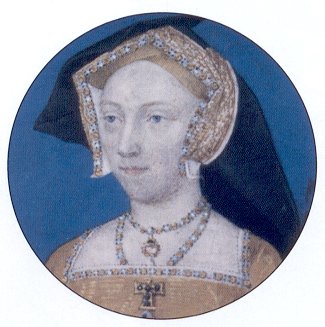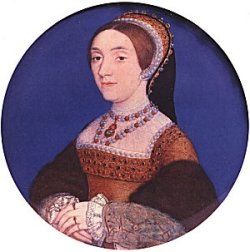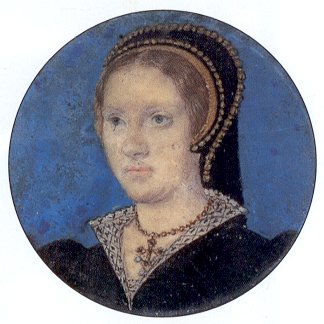One of my favourite eras of history is that of the English royalty, and specifically the times of the War of the Roses and the subsequent Tudor dynasty.
I will write a separate entry on the War of the Roses (sometimes called the Cousins’ War also) but one of the most spell-binding stories of the Tudor Dynasty centres around King Henry VIII and his six wives.
King Henry VIII
King Henry VIII was born at Greenwich on 28 June 1491, the second son of Henry VII and Elizabeth of York. He became heir to the throne on the death of his elder brother, Prince Arthur, in 1502 and succeeded in 1509.

Henry IIIV by Hans Holbein the Younger
Groomed to be the “spare heir” to the throne and not the planned inheritor, Henry in his youth was charming, intelligent and athletic. According to folklore, he had numerous female admirers (although that would change as he aged), but the woman he loved from a young age was the young Catalina (Spanish princess), Katharine of Aragon who sailed from Spain to England to become the future Queen of England. Poor Katharine became the first of Henry’s wives…
Katharine of Aragon
Born to King Ferdinand of Aragon and Queen Isabella of Castile (a fierce warrior queen in her own right, and worth a future entry on this blog!), Katharine was born believing she was destined for greatness. Growing up on the battlefields where her parents fought the Moors, she was betrothed as an infant to Arthur, Prince of Wales, to seal an alliance between Spain and England.
 Katharine, Age 16
Katharine, Age 16
(Portrait of Katharine of Aragon by Michael Sittow, c1502)
At the young age of 15, she set sail from her parents and her homeland and arrived on British soil. Her marriage to Prince Arthur lasted only six months before the young heir passed away. Katharine would swear that their marriage was never consummated, therefore allowing it to be declared null and void by the Church, and paving the way for her to be married eight years later to the new-heir to the throne, Prince Henry, upon his eighteenth birthday.
Despite being nearly ten years older than Henry, Catholic Katharine enthralled Henry and they lived a very happy life for many years, until Katharine’s child bearing ability (or lack of it) caused problems in the marital home. Katharine gave birth to a girl, Princess Mary, but a female cannot inherit the throne, and as the miscarriages continued over their 20 year marriage, Henry’s eye began to wander.
And it wandered all the way to Anne Boleyn, one of his many mistresses’ sister.
Anne Boleyn, the “other Boleyn girl”
Anne came from a wealthy London family, and her father had some influence in Henry’s court. Her family was ambitious, and in all likelihood, encouraged Henry’s infatuation with Anne and possibly covered their courtship from prying eyes.
Following Catherine’s many miscarriages, Anne (and her Protestant ways) enticed Henry with her promises of a male heir. However, Henry and Anne’s grand plans to produce a legitimate heir were somewhat derailed by the fact that Henry was already married, and the Pope was refusing to annul his
marriage to Katharine.

Portrait of Anne Boleyn by an unknown artist, late 16th century
Henry’s argument for the annulment was that Katharine’s wedding to his brother, Arthur, actually had been consummated. So, despite seeking and obtaining a dispensation in order to marry Katharine on the basis the marriage was not consummated, Henry then tried to have the same dispensation revoked. No wonder the Pope was not rapt with the idea.
Eventually, Thomas Cromwell (Henry’s Chief Advisor) sought another path to please the King and obtain the dissolution of his marriage to Katharine. Bypassing the Pope, they passed parliamentary Acts which reduced the power of the Pope in England and set the stage for the Reformation.
So, Henry’s wedding was declared invalid and within the week, he had married Anne of Boleyn, and Queen Katharine was cast out and made to live as a leper. Princess Mary was declared a bastard and therefore no longer a contender for the throne.
Unfortunately for Anne, she had no more luck tan her predecessor when it came to giving Henry a male heir. Anne gave birth to a baby girl (Princess Elizabeth) and like, Katharine, suffered miscarriages during her three year marriage to Henry.
Following a hunting accident which reduced Henry’s ability to exercise and pre-empted his ballooning weight, Henry began to once again, seek solace in the arms of another woman who could promise him a male heir. But how to get rid of his second wife?
Anne became the prime subject of a vendetta against the Protestant members of the Court and before long, there was apparently substantiated evidence of an adulterous and homosexual (which was against the law of the day) ring of sexual deviants, led by none other than the Queen herself. As the claims against the Queen added up (perhaps previous feuds being settled?), Cromwell led the charge to put her on trial for adultery and incest.
Of course, for a Queen to commit adultery and incest (yes, she was accused of incest with her brother), means she had committed high treason against the King, which equals a sentence of death. So, not more than four years after her marriage to Henry, Queen Anne found herself kneeling at the chopping block of the Tower of London, and then she was no more.
Jane Seymour
Meanwhile, shy, demure Jane Seymour (whose family were also well regarded Londoners) had caught Henry’s attention. Known throughout the Court as a peacemaker, an able needleworker (in direct contrast to her predecessors who were much more well read) and an all round lovely lady, Jane was 15 years younger than Henry when they married in 1536 (she was around 30 years) and won the love of the common people when she openly showed her sympathy for the then deceased Queen Katharine and her daughter Mary.

Miniature portrait of Jane Seymour by Lucas Horenbout
Through Jane’s advocacy on her behalf, Princess Mary and Henry reconciled and Princess Mary rejoined the Court becoming a friend and companion of Queen Jane. Within 18 months of the wedding, Jane gave birth to the future King Edward VI, the only male heir of Henry’s to survive infancy.
Sadly for Jane, she died two weeks after Edward’s birth due to complications of childbirth. interestingly, when he died in 1547, Henry was buried beside her, on his request, in the grave he had made for her.
Henry mourned Jane and did not remarry for three years. He did however, continue to suffer from gout, and he became more and more obese. By the time marriage negotiations had concluded, the next lucky Queen of England was another foreigner…
Anne of Cleves
Anne of Cleaves was the sister of the Duke of Cleaves and as Henry’s previous two marriages had been simply love matches (or more accurately, lust matches), his advisors strongly encouraged a marriage that would bring political advantage. True to form, Henry also wanted to ensure his fourth bride would be desirable and so once Anne of Cleves had been determined as a potential Queen, Henry sent one of his more famous Court painters, Hans Holbein, to the Cleves Court to paint Anne.

Miniature portrait of Anne of Cleves by Hans Holbein the Younger
At the time, Cleves was seen as an important political ally in the event France and the Holy Roman Empire (the Pope as the head) decided to move against the countries who had thrown off the Papal rule. So Henry’s advisors were seeking allies with countries who had been supporting the reformation of the Church. Henry also liked the look of Anne’s portrait, and so the marriage contract was drawn up, and Anne moved to England to meet her King.
The story goes that before Anne had even arrived in England, Henry had already begun to doubt his advisors’ claims that an alliance with Cleves was the way to go. So, when he finally did meet her, and was less than impressed with her beauty (he said she looked like a horse!), nobody was very surprised when he demanded his people find a way to have the latest marriage annulled. Annoyed, frustrated, andy? Yes, but surprised? I doubt it.
Now, Anne might not have been the most beautiful bride Henry had had, but she was certainly the most wary, and after learning of the demise of Henry’s first couple of wives, Anne decided there was no way in hell she was going to make life difficult for Henry.
So, upon consultation with her advisors, she ended up agreeing with Henry that in fact, her earlier betrothal to a nobleman had in fact been legal, that her marriage to Henry was unconsummated, and that on these grounds, her marriage to Henry could be dissolved. Smart girl.
To reward her for her loyalty, Henry bestowed upon Anne the honorary title of “Anne, the King’s Sister” and she was given property, including Hever Castle, formally the home of Anne Boleyn. Yep, you heard that right, Henry called her his sister, and granted her the prestige afforded the sister of the King. In fact, they remained relatively close, and Anne was actually given pride of place amongst the Court at her former stepdaughter, Princess Mary’s, coronation.
Anne lived the remainder of her days away from Court in the countryside, never returning to her homeland, and was eventually buried in a nondescript tomb in Westminster Abbey.
Catherine Howard
So who was Henry’s fifth wife? Well, one of Anne Boleyn’s first cousins, and one of Queen Anne of Cleve’s ladies’ in waiting, was a young, vivacious, flirtatious femme fatale called Catherine Howard. It is assumed Catherine seduced Henry on the orders, or direction, or suggestion of her powerful family (let’s not forget, Catherine’s father and Anne Boleyn’s father were brothers, so they knew what to expect when it came to Henry), and within sixteen days of being rid of Anne of Cleves, Henry and Catherine married.
The kicker? Henry was 49 and his bride was no older than 19.

Miniature portrait of Catherine Howard by Hans Holbein the Younger
Henry doted on Catherine and widely referred to her as his “rose without a thorn” – she reintroduced dancing and festivities to the Court and the King became more lively and animated in her presence. However, it was probably not surprising that it was not long before rumours of Catherine’s infidelity and frivolity begins to spread around the Court.
Despite not wanting to believe it, and refusing to do so at first, after a year of warnings from his advisors, Henry allowed a full investigation into Catherine’s alleged promiscuities and so began her undoing. She was found guilty of an affair with one of her many admirers (who she had unfortunately promoted to a advisory position within her Court) and on top of this, she was named as ‘tainted goods” prior to their wedding, which was clearly unsuitable for a royal.
Poor beautiful, bonny and becoming Catherine was executed on the Tower Green on February 13, 1542 and laid to rest near her cousin Anne Boleyn. How ironic.
Phew. Bet you’re wondering how Henry could handle any more wives? I think he was too, by this point!
Katharine Parr
Katharine Parr was already twice married and widowed when she caught the attention of King Henry within a year of Catherine’s death, and, as expected they were married not six months later. Katharine was said to be a patron of the arts and well spoken, she was the first Queen to ever have a book of prayers in her own name published.

Miniature portrait of Katharine Parr by Lucas Horenbout
Being close in age her Henry’s now three children, Katharine was close to all of them and personally involved in Elizabeth and Edward’s education.
(Now, Katharine’s story probably only gets scandalous following the death of poor Henry the 8th, so let’s jump ahead slightly to finish this interesting insight into England’s history.)
Following a marriage of not longer than three years, Henry died in 1547 and Katharine Parr became the last in his long list of wives. She had probably expected to play a leading role in the regency of the new nine year old King, Edward VI but she allowed her heart to duke her head. Within only a few months of Henry’s death, Katherine secretly married Thomas Seymour (yes, that’s right, the previous Queen Jane Seymour’s Katharine), and the rapidness of the marriage unsettled the Court and caused a scandal, forcing Katharine and Thomas to set up their home away from Court.
Queen Katharine was somehow allowed to be Princess Elizabeth’s guardian, but before too long, there were rumours of Elizabeth and Thomas having an improper sexual relationship, and the young Princess was sent to another household. Katharine fell pregnant at the age of 36 (about 18 months after Henry’s death) and unfortunately for her, soon after giving birth to a daughter in September 1548, she fell ill with perpetual fever and died.
So, there you have it. Mad King Henry and his six wives.
“Divorced, Beheaded, Died
Divorced, Beheaded, Survived”
And thus shall Henry’s six wives be remembered.
Disclaimer: I have read numerous books and articles on the War of the Roses and Tudor History, and it is important to note that this is by no means meant to be a cite-worthy site for your own research. The purpose of this blog is to trigger an interest in moments of history, or historical people, so you will go away and conduct your own further research if required. This entry is my recollection of the history of Henry as I recall learning it (with key facts such as years of marriage checked). I want to share my passion for the interesting people of our past, and hope this will provide food for thought 